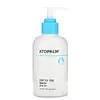What's inside
What's inside
 Key Ingredients
Key Ingredients

 Benefits
Benefits

 Concerns
Concerns

 Ingredients Side-by-side
Ingredients Side-by-side

Glycerin
HumectantWater
Skin ConditioningCocamidopropyl Betaine
CleansingDisodium Cocoamphodiacetate
CleansingHippophae Rhamnoides Fruit/Seed Oil
AntimicrobialRosa Canina Fruit Oil
EmollientSimmondsia Chinensis Seed Oil
EmollientSqualane
EmollientPyrus Malus Fruit Extract
Skin ConditioningPolyquaternium-10
Maltodextrin
AbsorbentSorbitan Oleate Decylglucoside Crosspolymer
CleansingPhenoxyethanol
PreservativeCocos Nucifera Fruit Extract
EmollientVanilla Planifolia Fruit Extract
Skin ConditioningGardenia Jasminoides Fruit Extract
Cosmetic ColorantEugenia Caryophyllus Flower Extract
AstringentPrunus Armeniaca Fruit Extract
Skin ConditioningPrunus Persica Fruit Extract
AbrasiveCitric Acid
BufferingEthylhexylglycerin
Skin ConditioningTetrasodium Glutamate Diacetate
Glycerin, Water, Cocamidopropyl Betaine, Disodium Cocoamphodiacetate, Hippophae Rhamnoides Fruit/Seed Oil, Rosa Canina Fruit Oil, Simmondsia Chinensis Seed Oil, Squalane, Pyrus Malus Fruit Extract, Polyquaternium-10, Maltodextrin, Sorbitan Oleate Decylglucoside Crosspolymer, Phenoxyethanol, Cocos Nucifera Fruit Extract, Vanilla Planifolia Fruit Extract, Gardenia Jasminoides Fruit Extract, Eugenia Caryophyllus Flower Extract, Prunus Armeniaca Fruit Extract, Prunus Persica Fruit Extract, Citric Acid, Ethylhexylglycerin, Tetrasodium Glutamate Diacetate
Water
Skin ConditioningDisodium Cocoyl Glutamate
CleansingDisodium Cocoamphodiacetate
CleansingPropanediol
SolventGlycerin
HumectantSodium Chloride
MaskingCoco-Glucoside
CleansingXanthan Gum
EmulsifyingSodium Sweetalmondamphoacetate
CleansingMyristoyl/Palmitoyl Oxostearamide/Arachamide Mea
Skin ConditioningSimmondsia Chinensis Seed Oil
EmollientHelianthus Annuus Seed Oil
EmollientVitis Vinifera Seed Oil
EmollientCarthamus Tinctorius Seed Oil
MaskingCamellia Sinensis Seed Oil
HumectantCentella Asiatica Extract
CleansingMadecassoside
AntioxidantCocodimonium Hydroxypropyl Hydrolyzed Wheat Protein
CleansingSodium Phytate
Citric Acid
BufferingSodium Citrate
BufferingHexylene Glycol
Emulsifying1,2-Hexanediol
Skin ConditioningCaprylyl Glycol
EmollientArtemisia Vulgaris Oil
PerfumingSantalum Album Oil
MaskingWater, Disodium Cocoyl Glutamate, Disodium Cocoamphodiacetate, Propanediol, Glycerin, Sodium Chloride, Coco-Glucoside, Xanthan Gum, Sodium Sweetalmondamphoacetate, Myristoyl/Palmitoyl Oxostearamide/Arachamide Mea, Simmondsia Chinensis Seed Oil, Helianthus Annuus Seed Oil, Vitis Vinifera Seed Oil, Carthamus Tinctorius Seed Oil, Camellia Sinensis Seed Oil, Centella Asiatica Extract, Madecassoside, Cocodimonium Hydroxypropyl Hydrolyzed Wheat Protein, Sodium Phytate, Citric Acid, Sodium Citrate, Hexylene Glycol, 1,2-Hexanediol, Caprylyl Glycol, Artemisia Vulgaris Oil, Santalum Album Oil
 Reviews
Reviews

Ingredients Explained
These ingredients are found in both products.
Ingredients higher up in an ingredient list are typically present in a larger amount.
Citric Acid is an alpha hydroxy acid (AHA) naturally found in citrus fruits like oranges, lemons, and limes.
Like other AHAs, citric acid can exfoliate skin by breaking down the bonds that hold dead skin cells together. This helps reveal smoother and brighter skin underneath.
However, this exfoliating effect only happens at high concentrations (20%) which can be hard to find in cosmetic products.
Due to this, citric acid is usually included in small amounts as a pH adjuster. This helps keep products slightly more acidic and compatible with skin's natural pH.
In skincare formulas, citric acid can:
While it can provide some skin benefits, research shows lactic acid and glycolic acid are generally more effective and less irritating exfoliants.
Most citric acid used in skincare today is made by fermenting sugars (usually from molasses). This synthetic version is identical to the natural citrus form but easier to stabilize and use in formulations.
Read more about some other popular AHA's here:
Learn more about Citric AcidDisodium Cocoamphodiacetate is a surfactant and helps cleanse skin. It is created from the fatty acids of coconut oil.
Surfactants help rinse oil, dirt, and other pollutants easily from skin. It has a faint fruit-like scent.
Glycerin is already naturally found in your skin. It helps moisturize and protect your skin.
A study from 2016 found glycerin to be more effective as a humectant than AHAs and hyaluronic acid.
As a humectant, it helps the skin stay hydrated by pulling moisture to your skin. The low molecular weight of glycerin allows it to pull moisture into the deeper layers of your skin.
Hydrated skin improves your skin barrier; Your skin barrier helps protect against irritants and bacteria.
Glycerin has also been found to have antimicrobial and antiviral properties. Due to these properties, glycerin is often used in wound and burn treatments.
In cosmetics, glycerin is usually derived from plants such as soybean or palm. However, it can also be sourced from animals, such as tallow or animal fat.
This ingredient is organic, colorless, odorless, and non-toxic.
Glycerin is the name for this ingredient in American English. British English uses Glycerol/Glycerine.
Learn more about GlycerinThis oil comes from the seeds of the desert shrub called Jojoba. It is more commonly known as jojoba oil, a non-comedogenic oil.
Jojoba oil does not contain fragrance and has many fatty-acids, making it a great soothing ingredient.
It also contains Vitamin E, a great moisturizing ingredient. Vitamin E is also an antioxidant and protects your skin against oxidative damage.
This ingredient humectant properties, meaning it helps draw moisture from the air. This helps keep your skin hydrated.
While jojoba has antibacterial properties, it is only able to kill some strains of bacteria.
Studies also show it helps in wound healing. In fact, Indigenous cultures have used jojoba as a moisturizer and to help treat burns for centuries.
Fun fact: Jojoba oil similar to natural human skin sebum, so it has a great effect on dry skin. It is also promising with helping to regulate sebum production.
Due to its fatty acid content, Jojoba oil may not be fungal acne safe. We recommend speaking with a professional if you have any concerns.
Learn more about Simmondsia Chinensis Seed OilWater. It's the most common cosmetic ingredient of all. You'll usually see it at the top of ingredient lists, meaning that it makes up the largest part of the product.
So why is it so popular? Water most often acts as a solvent - this means that it helps dissolve other ingredients into the formulation.
You'll also recognize water as that liquid we all need to stay alive. If you see this, drink a glass of water. Stay hydrated!
Learn more about Water